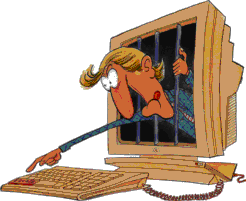

I started my computer career at the beginning of the 80s aged about 15 years, which was relatively young in those times. My (elder) brother had bought himself a programable scientific calculator, a HP 33 with UPN logic and with storage for incredible 49 program steps! With this machine I spent my time designing programs, which were as short and as clever as possible, for computing the faculty of a number. Then, a school friend of my brother made a step forward and bought a so-called "Basic-Sharp", a scientific calculator which was programable in Basic and had a program storage of 1 KB. With that machine, it was possible to write relatively clever programs, and I drove this guy mad because I visited him obviously too often in order to improve my own programing skills.
In my school of those days (the high school "Albert-Schweitzer-Gymnasium" in Neckarsulm) we had several Commodore PET (Personal Electronic Transactor, those machines with horrible plastic keyboards and a cassette drive for program and data storgae, which had neither a counter nor any other facility to localize the tape position, and which was normally de-adjusted in such a way that reading the data was not possible beside on that drive where the data had been written if it was possible at all to read the data) and CBM (Commodore Business Machines). The disadvantage: Only scholars from the upper school were allowed to enter the computer hall. I just was at the tenth grade and, according to the opinion of my teachers, I was too young for computer!
My first own computer was a Commodore C 64, which I bought on November 12, 1983 (for that, I especially looked on the original bill) and which was accompanied by the obligatory datasette and, short time after, by a floppy disk drive. But well, it was not just one floppy drive: that part was returned several times due to de-adjustment for repair and replacement on warranty (this replacement was performed sometimes by just changing the case, but the mechanical and electrical parts, which I got back, were the same as before). and finally, due to missing success of these tries I returned it and was refunded my money, before I could get aware of some more stable (but very seldom) sample of the model variant with knob opener. Beside various programs which I programmed in Commodore Basic, I used the C 64 mainly to program sound and graphical routines in 6502 assembler as a supplement of the built-in "Commodore Basic", which could not make use of the computer's great multi media features, and as well to play games, of course (e.g. "Hobbit", the legendary adventure with text and graphics, and "Summer Games" will stay forever in my memory, as well).
Already in the occupation with my C 64 there were visible signs for my later career in telecommunications: together with some school friend of my brother (another one than the one already mentioned above), who had an Apple II compatible computer (unfortunately not my brother, but his school friend had that machine, that is why I often stayed not at home, those times), we built a simple cable, which connected my C 64 and his Apple II via four lines (two data lines and two handshake lines as well as the obligatory ground line), and I wrote the communication software to control the I/O chips (6522/6526) in assembler, which allowed a serial data communication (where each single bit was confirmed for its own with the help of the two handshake lines, which made it a "full duplex handshake") between both computers.
My first exercises in computer science at the university were mainly influenced by the usage of Apple II computers with additional Z80 CPU card (beside the built-in 6502 CPU), on which we used interpreters for UCSD Pascal and MC68000 assembler (never before, a MC68000 program ran slower than in such an environment).
In my first winter holidays at the university, I voluntarily took part in a compact course to learn the program language Fortran and used a Univac for that, which was fed with perforated cards and where we waited in front of the lineprinter for the output: not just a modern programming language on a little bit antique system with an input and output technique of very old times. By the way, in that course I was the only (voluntary) computer scientist among lots of engineers, for whom this was a must.
As a student with IBM I had my first experience with PCs. Beside that, I used several IBM hosts running MVS and VM, mainly in order to program macros for the creation of graphical objects in the text formatting tool DCF (Document Composition Facility).
Most of my time at the university was impressed by the use of various computer models from DEC (PDP11, VAX, VAXstation, DECstation mit MIPS- und Alpha-Prozessor) running several operating systems (VMS and various Unix derivatives, especially Ultrix and OSF/1).
Away from the university and in the middle of "Real Life" I had to step down to the world of Intel PCs running MS Windows at my working place. There I mainly used this platform for standard office applications to create documents as e.g. texts, speadsheets, and presentation slides.
Here, the hardware platform remained the same (Intel PC), but the operating system changed significantly (Linux). At the same time, the type of computer usage changed: we implemented new network technologies within the Linux kernel, and with various multimedia applications we tested the extented network functionality.

After a very long time of freedom from computers in my private life, in June 1998 something became reality, which I could not imagine before for a very long time: I bought a PC. But of course, I immediately installed Linux as operating system in order to replace the pre-installed Windows95 by a "real operating system"!
As it is appropriate for a "real" computer scientist with the speciality telecommunications and networks, now I also have my own private network at home. This actually consists of the following components:
 Besides for myself
(as here on my own homepage),
I sometimes use my knowledge
for others as well,
as e.g. for the
Guinness world record
"Chess on the right and left side of the Neckar",
which took place on Sunday,
July 8, 2001.
At this event,
which was realized by
STR Mannheim-Lindenhof
in the Baumhain hall in the Luisenpark in Mannheim,
I was responsible for the creation of the
web presentation
(which is no longer online, unfortunately).
Besides for myself
(as here on my own homepage),
I sometimes use my knowledge
for others as well,
as e.g. for the
Guinness world record
"Chess on the right and left side of the Neckar",
which took place on Sunday,
July 8, 2001.
At this event,
which was realized by
STR Mannheim-Lindenhof
in the Baumhain hall in the Luisenpark in Mannheim,
I was responsible for the creation of the
web presentation
(which is no longer online, unfortunately).